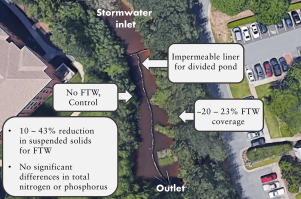当前位置:
X-MOL 学术
›
Ecol. Eng.
›
论文详情
Our official English website, www.x-mol.net, welcomes your feedback! (Note: you will need to create a separate account there.)
Floating treatment wetland retrofit in a stormwater wet pond provides limited water quality improvements
Ecological Engineering ( IF 3.8 ) Pub Date : 2020-04-01 , DOI: 10.1016/j.ecoleng.2020.105784 Bryan Maxwell , Danielle Winter , François Birgand
Ecological Engineering ( IF 3.8 ) Pub Date : 2020-04-01 , DOI: 10.1016/j.ecoleng.2020.105784 Bryan Maxwell , Danielle Winter , François Birgand

|
Abstract Floating treatment wetlands (FTW) are an emerging management practice for improving water quality in stormwater wet ponds or other detention basins. Although there is substantial evidence of nutrient reductions by FTW in mesocosm-scale studies, findings from field-scale studies on the water quality benefits of FTW are less conclusive. A medium-sized stormwater wet pond (~0.8 ha) was partially divided using an impermeable liner and monitored for 280 d using a control and FTW treatment (~20–23% FTW coverage) to determine impact of FTW on concentrations of several water quality parameters at the field-scale. Discrete samples and high-frequency, multi-point monitoring were used to assess water quality differences. No significant differences between the two treatments were found for total nitrogen, total Kjeldahl nitrogen, or total phosphorus, based on discrete samples, and in situ monitoring showed dissolved oxygen was significantly lower in the FTW treatment by roughly 2.6 mg L−1. The FTW treatment had significantly higher nitrate concentrations in discrete samples, but this finding was not supported by the high-frequency data collected when considering the full monitoring period. The FTW had significantly lower total suspended solids, based on discrete and high-frequency sampling, and resulted in a 10–43% reduction in TSS (~25% mean reduction), relative to the control. Comparison of subsets of the high-frequency data to discrete sampling data demonstrated how limited discrete sampling can lead to partial information and potentially erroneous conclusions when assessing FTW treatment effect in stormwater, especially when differences in water quality chemistry are small.
中文翻译:

雨水湿池中的浮动处理湿地改造提供有限的水质改善
摘要 浮动处理湿地 (FTW) 是一种新兴的管理实践,用于改善雨水湿池或其他滞留池的水质。尽管在中宇宙尺度研究中有大量证据表明 FTW 会减少养分,但关于 FTW 水质益处的现场规模研究的结果并不具有决定性。 .. . . . . . . . . . . . . . . . . . . . . . . . . . . . . . . . . . . . . . . . . . . . . . . . . . . . . . . . . . . . . . . . . . . . . . . . . . . . . . . . . . . . . . . . . . . . . . . . . . . . . . . . . . . . . . . . . . . . . . . . . . . . . . . . . . 一个中型雨水湿池(约 0.8 公顷)使用不透水衬里部分划分,并使用对照和 FTW 处理(约 20-23% FTW 覆盖率)监测 280 天,以确定 FTW 对几种水质浓度的影响场尺度上的参数。离散样本和高频、多点监测用于评估水质差异。两种处理在总氮、总凯氏氮或总磷方面没有发现显着差异,基于离散样品,原位监测显示 FTW 处理中的溶解氧显着降低了大约 2.6 mg L-1。FTW 处理在离散样品中具有显着更高的硝酸盐浓度,但在考虑完整监测期时收集的高频数据不支持这一发现。基于离散和高频采样,FTW 的总悬浮固体显着降低,与对照相比,TSS 降低了 10-43%(平均降低了 25%)。高频数据子集与离散采样数据的比较表明,在评估雨水中的 FTW 处理效果时,尤其是当水质化学差异很小时,有限的离散采样会导致部分信息和潜在的错误结论。
更新日期:2020-04-01
中文翻译:

雨水湿池中的浮动处理湿地改造提供有限的水质改善
摘要 浮动处理湿地 (FTW) 是一种新兴的管理实践,用于改善雨水湿池或其他滞留池的水质。尽管在中宇宙尺度研究中有大量证据表明 FTW 会减少养分,但关于 FTW 水质益处的现场规模研究的结果并不具有决定性。 .. . . . . . . . . . . . . . . . . . . . . . . . . . . . . . . . . . . . . . . . . . . . . . . . . . . . . . . . . . . . . . . . . . . . . . . . . . . . . . . . . . . . . . . . . . . . . . . . . . . . . . . . . . . . . . . . . . . . . . . . . . . . . . . . . . 一个中型雨水湿池(约 0.8 公顷)使用不透水衬里部分划分,并使用对照和 FTW 处理(约 20-23% FTW 覆盖率)监测 280 天,以确定 FTW 对几种水质浓度的影响场尺度上的参数。离散样本和高频、多点监测用于评估水质差异。两种处理在总氮、总凯氏氮或总磷方面没有发现显着差异,基于离散样品,原位监测显示 FTW 处理中的溶解氧显着降低了大约 2.6 mg L-1。FTW 处理在离散样品中具有显着更高的硝酸盐浓度,但在考虑完整监测期时收集的高频数据不支持这一发现。基于离散和高频采样,FTW 的总悬浮固体显着降低,与对照相比,TSS 降低了 10-43%(平均降低了 25%)。高频数据子集与离散采样数据的比较表明,在评估雨水中的 FTW 处理效果时,尤其是当水质化学差异很小时,有限的离散采样会导致部分信息和潜在的错误结论。



























 京公网安备 11010802027423号
京公网安备 11010802027423号